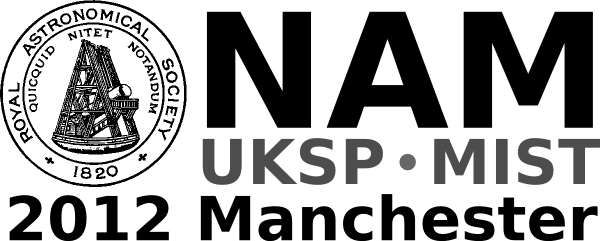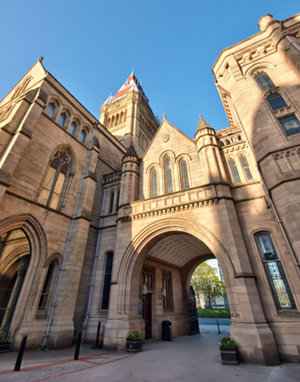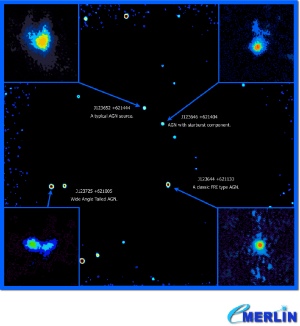UK-Germany National Astronomy Meeting NAM2012
e-MERLIN's deep radio survey of the Hubble Deep Field: first results
Royal Astronomical Society press release
RAS 12/17 (NAM 8)
Tuesday 27 March 2012
A team of astronomers at Jodrell Bank Observatory have begun the deepest ever high-resolution radio imaging of the region around the Hubble Deep Field (HDF), the images originally captured by the Hubble Space Telescope (HST) in the mid 1990s. The HDF led to the discovery of numerous galaxies billions of light years distant and provided direct visual evidence of the evolution of the Universe. First results from the new imaging, which uses observations from the UK's newly upgraded e-MERLIN radio telescope array together with the EVLA radio array based in New Mexico, show galaxies some 7 billion light years away in unprecedented detail. Graduate student Nick Wrigley will present the new results at the National Astronomy Meeting in Manchester on 27 March 2012.
e-MERLIN is an array of radio telescopes distributed across the United Kingdom connected together by optical fibres. Data from each telescope is sent across this network to Jodrell Bank where a device known as a 'correlator' processes them into a single image. This technique, known as interferometry, simulates a single radio telescope hundreds of kilometres across and produces exceptionally sharp images of astronomical objects.
EVLA is a similar more compact array in New Mexico in the United States that shows the coarser structure of objects and complements the e-MERLIN observations. The two arrays started to survey the HDF region in 2011 and the team expect the project to be completed in the next few years.
The first wide-band images of the whole HDF region capture the brightest objects in the field at sub-arcsecond resolution, equivalent to being able to distinguish a ten pence piece at a distance of over 5 kilometres. The pictures were assembled by Mr Wrigley under the supervision of Dr Rob Beswick and Dr Tom Muxlow at the Jodrell bank Centre for Astrophysics in Manchester. The image in the background, observed using the EVLA, shows the unresolved emission from whole galaxies, whereas the inset images produced using mapping in combination with e-MERLIN show the fine detail.
The high resolution provided by e-MERLIN allows astronomers to distinguish between the different types of galaxies, identifying those that have emission from material being dragged into supermassive black holes (so called Active Galactic Nuclei or AGNs) and those where the emission originates from rapid star formation or starbursts. The HDF galaxies are so far away that the light we see from them left as long ago as 12 billion years ago, so the new radio observations are giving us an insight into the formation of stars when the universe was less than 10% of its present age.
This new work is just the start of a multi-year survey of the HDF and provides a glimpse of the capabilities of wide-band (broadband data transmission) synthesis imaging now possible with simultaneous use of the e-MERLIN and EVLA arrays. Crucially, the e-MERLIN and EVLA correlators now generate compatible data allowing future observations to be combined like never before.
The first images were made with relatively short exposure times, but the whole project, named e-MERGE (led by Dr. Tom Muxlow (Manchester), Prof. Ian Smail (Durham) & Prof. Ian McHardy (Southampton)) will include long observations gathered at various wide-bands within the radio spectrum generating an unsurpassed combination of sensitivity and detail. The survey will ultimately measure massive star formation and AGN activity in very distant galaxies, tracing the development of the stellar populations and black hole growth in the very first large galaxies. Using the more accurate observations from e-MERLIN, it will be possible to produce more precise models of the physical process of star formation within star clusters in such galaxies and help to answer some of the many questions faced by cosmologists today.
IMAGE AND CAPTION
An image of the new results (live from Monday 26 March) can be downloaded from http://www.jb.man.ac.uk/~nwrigley/web/index.html
Caption: Image composed from e-MERLIN and EVLA observations in C-band. The width of the whole field is approximately 1/4 of a degree (the same diameter as half a full moon). The inset images illustrate the effectiveness of e-MERLIN's capabilities in revealing the structure of galaxies even at distances of billions of the light years. Bottom left: An interesting example of an AGN galaxy with large lobes thought to be caused by jets, emanating from a central black hole, interacting with interstellar material. Bottom right: An FR1 type AGN galaxy. Top left: A more typical AGN type galaxy. Top right: An AGN with star formation characteristic emission detected at an estimated distance of 7.5 billion light-years. Credit: N. Wrigley / Jodrell Bank Centre for Astrophysics
MEDIA CONTACTS
NAM 2012 Press Office (0900 - 1730 BST, 27-29 March; 0900 - 1630 BST 30 March)
Room 3.214
University Place building
University of Manchester
Manchester
UK
Tel: +44 (0)161 306 7313
Dr Robert Massey
Royal Astronomical Society
Mob: +44 (0)794 124 8035
Email: rm@ras.org.uk
Anita Heward
Royal Astronomical Society
Mob: +44 (0)7756 034 243
Email: anitaheward@btinternet.com
Dr Klaus Jaeger
Pressereferent / Press Officer im Vorstand der Astronomischen Gesellschaft
Tel: +49 6221 528 379
Email: pressereferent@astronomische-gesellschaft.de
Dan Cochlin
Media Officer (Faculty of Engineering and Physical Sciences)
University of Manchester
Tel: +44 (0)161 275 8387
Email: daniel.cochlin@manchester.ac.uk
SCIENCE CONTACTS
Dr Tom Muxlow
Jodrell Bank Centre for Astrophysics
The University of Manchester
Tel: +44 (0)161 275 4108
Email: tom.muxlow@manchester.ac.uk
Dr Rob Beswick
Jodrell Bank Centre for Astrophysics
The University of Manchester
Tel: +44 (0)161 275 0483
Email: Robert.Beswick@manchester.ac.uk
Mr Nick Wrigley
Jodrell Bank Centre for Astrophysics
The University of Manchester
Tel: +44 (0)161 275 4144
E-mail: nicholas.wrigley@postgrad.manchester.ac.uk
NOTES FOR EDITORS
NAM 2012
Bringing together more than 900 astronomers and space scientists, the National Astronomy Meeting (NAM 2012) will take place from 27-30 March 2012 in the University Place conference centre at the University of Manchester in the UK. The conference is a joint meeting of the Royal Astronomical Society (RAS) and the German Astronomische Gesellschaft (AG) and is held in conjunction with the UK Solar Physics (UKSP: www.uksolphys.org) and Magnetosphere Ionosphere Solar Terrestrial (MIST: www.mist.ac.uk) meetings. NAM 2012 is principally sponsored by the RAS, AG, STFC and the University of Manchester.
The Royal Astronomical Society
The Royal Astronomical Society (RAS: www.ras.org.uk), founded in 1820, encourages and promotes the study of astronomy, solar-system science, geophysics and closely related branches of science. The RAS organises scientific meetings, publishes international research and review journals, recognizes outstanding achievements by the award of medals and prizes, maintains an extensive library, supports education through grants and outreach activities and represents UK astronomy nationally and internationally. Its more than 3500 members (Fellows), a third based overseas, include scientific researchers in universities, observatories and laboratories as well as historians of astronomy and others.
The Astronomische Gesellschaft (AG)
The Astronomische Gesellschaft (AG: www.astronomische-gesellschaft.de), founded in 1863, is a modern astronomical society with more than 800 members dedicated to the advancement of astronomy and astrophysics and the networking between astronomers. It represents German astronomers, organises scientific meetings, publishes journals, offers grants, recognises outstanding work through awards and places a high priority on the support of talented young scientists, public outreach and astronomy education in schools.
The Science and Technology Facilities Council
The Science and Technology Facilities Council (STFC: www.stfc.ac.uk) is keeping the UK at the forefront of international science and tackling some of the most significant challenges facing society such as meeting our future energy needs, monitoring and understanding climate change, and global security. The Council has a broad science portfolio and works with the academic and industrial communities to share its expertise in materials science, space and ground-based astronomy technologies, laser science, microelectronics, wafer scale manufacturing, particle and nuclear physics, alternative energy production, radio communications and radar. It enables UK researchers to access leading international science facilities for example in the area of astronomy, the European Southern Observatory.
Jodrell Bank Centre for Astrophysics
The Jodrell Bank Centre for Astrophysics (JBCA: www.jb.man.ac.uk) is part of the School of Physics & Astronomy at the University of Manchester. JBCA is split over two main sites: the Alan Turing Building in Manchester and the Jodrell Bank Observatory in Cheshire. At Jodrell Bank Observatory, the new Jodrell Bank Discovery Centre is a key focus for our work in public engagement and education. Jodrell Bank is a world leader in radio astronomy-related research and technology development with a research programme extending across much of modern astrophysics. The group operates the e-MERLIN national radio astronomy facility and the iconic Lovell Telescope, hosts the UK ALMA Regional Centre Node and is home to the international office of the SKA Organisation. Funded by the University, the Science & Technology Facilities Council and the European Commission, it is one of the UK's largest astrophysics research groups.






